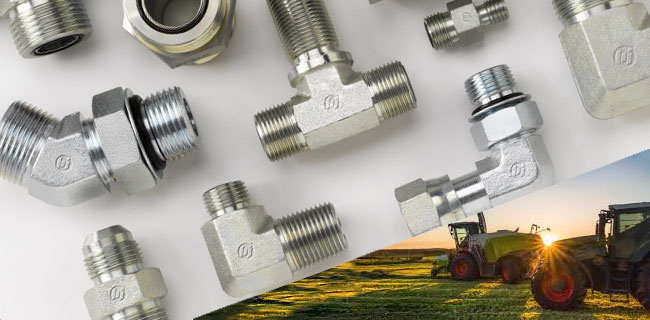O-ring face seals can eliminate leaks in many hydraulic applications and instrumentation systems. These common fittings should conform to the SAE J1453 standard and are often made manufactured from carbon, nickel-plated carbon, or stainless steel. According to industry leader Brennan Inc., the type of O-ring commonly used with this fitting is either Buna-N, Viton, or 90 Durometer O-rings that seat into a groove in the face of a fitting. Seals are created when the O-ring is compressed onto the female machined flat face, similar to split flange type fittings. When the connection is tightened, the O-ring compresses against a flat face sleeve at the end of a tube, creating a metal to metal seal.
These flat face O-rings are often called elastomeric seals and are very common in hydraulic and tube connections. An elastomeric seal is a rubber-like seal that is essentially leak-proof and O-ring face seal fittings from Brennan Inc. can eliminate leaks in hydraulic systems that have operating systems as high as 6,000 psi.
Learn how to identify O-Ring face seal fittings. Watch this video from Brennan:
CONTACT US TODAY TO DISCUSS YOUR NEEDS OR TO SCHEDULE AN ONSITE CONSULTATION AT 314-638-6500 OPTION 4.
Choosing the Right O-Ring Face Seal Fitting: The Cost of a Slow Leak
Aside from the cost of equipment maintenance and downtime, a slow leak can be expensive. Given the price of hydraulic fluid, imagine your connection fittings leak 1 drop of hydraulic oil per minute. According to Brennan Inc., that adds up to 50 gallons of waste per year — or roughly $1,250. What if it’s a faster leak? Just 1 drop every second can add up to 3,000 gallons of wasted hydraulic fluid or $75,000.
Not only can ORFS fittings prevent component failure and be used in static applications, such as hoses conveying fluids, but they can also be used in dynamic applications like rotating pump shafts and pistons.
Although O-ring face seals for hydraulic hose fittings are efficient in eliminating leaks in high-pressure applications, there is potential for a leak to occur if the O-ring face seals are of inferior quality or have been improperly installed. Additionally, regular equipment and hose maintenance is required. For more information on installation and maintenance, refer to the full SAE J1453 for ORFS fittings. The standard covers everything from dimensions, threads, fitting, material and performance requirements to ensure your tractor, combine or other heavy equipment runs to its fullest potential.
Call 314-638-6500 OPTION 4 for more information.
LEARN MORE ABOUT SUPERIOR INDUSTRIAL SUPPLY PRODUCTS AND SERVICES.
How to Assemble Your O-Ring Face Seal Fitting in 4 Steps
It doesn’t matter what fitting you use, if it’s not installed correctly leaks are an inevitable consequence. These are a few recommendations from Brennan Inc. when assembling your O-ring face seal:
- Inspect for damage.
Be sure to thoroughly examine your fitting and look for any signs of damage — even if the fitting is brand new. Sometimes, damage or contamination can occur when shipped or stored. - Lubricate regularly.
Using the system’s hydraulic fluid, lubricate the threads and the O-ring. This is called wet torqueing and is just one method of properly lubricating your O-ring and fitting threads for proper placement. - Ensure a good seat.
Make sure that the O-ring is properly seated in the groove of the fitting’s face and have the face seal flange mated with the O-ring. Then, finger tighten the flange nut. - Apply proper installation torque.
To ensure the best seal, only use the properly rated torque value to tighten the flange nut. Contact the manufacturer for exact values. Remember that overtightening can be just as problematic as under-tightening.
If you have questions on how Superior can help you improve operations and extend the life of your hydraulic systems with the right O-ring face seal fittings, stop into our St. Louis location, or call 314-638-6500 OPTION 4.

